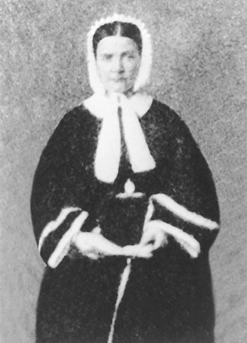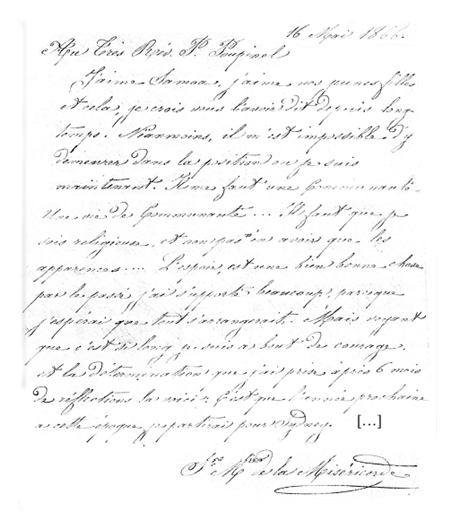14/04/2024
Deceased Sister: Sœur Claudine Nakamura (Sister Marie Yorokobi)
10/04/2024
Deceased Sister: Sister Frances Marie Lagan
10/04/2024
Deceased Sister: Soeur Marie Claudia SANTSCHI
10/04/2024
Deceased Sister: Sister Mary Aquin Maloney (Kathleen Margaret Maloney)
09/04/2024
Deceased Sister: Sœur Madeleine FASSION
09/04/2024
Deceased Sister: Sœur Malia Visesio Paulo Katoa (Sister Marie Vincent de Paul)
09/04/2024
Deceased Sister: Sœur Angela BULLINI






Our pioneers | The Vocation of the Pioneers
 Marie Basset was born in St Laurent-de-Chamousset, France, on 2 November 1830. As a young woman, she responded to the appeal of Bishop Bataillon for mission in Oceania, but as she shared later, she also wanted religious life (cf. Miséricorde- Guillot, 06.03.1858, Letter 4, §9*). She was gifted with intelligence, common sense and had received a good education.
Marie Basset was born in St Laurent-de-Chamousset, France, on 2 November 1830. As a young woman, she responded to the appeal of Bishop Bataillon for mission in Oceania, but as she shared later, she also wanted religious life (cf. Miséricorde- Guillot, 06.03.1858, Letter 4, §9*). She was gifted with intelligence, common sense and had received a good education.
Having been received into the Third Order of Mary (November 1857), she left France with Srs Marie de la Pitié and Marie de la Sainte-Espérance. On arriving in Futuna, she set to work to teach. But she had little more than 2 months to settle in before Bishop Bataillon sent her and Marie de la Sainte-Espérance to Wallis. Of this beginning, she writes “for the 18 months I have been in Wallis I have found only obstacles in the way of my ardent desire to do something for the glory of God and the good of young people ” (Miséricorde-Favre, 04.01.1860, Letter 14, §2, OPS I, 177). Before long they were asked to work on a farm at Lano. Marie de la Miséricorde knew this was not what she had come to do as a missionary. From Sydney, in 1863 where she went for health reasons, she wrote: “Perhaps it is necessary that the work begun in Wallis be completely destroyed, and that the sisters disappear from the island for a while, so that in the future,if desirable they can be treated quite differently from how they have been up until now...” (Miséricorde-Yardin, 16.12.1863, Letter 27, §3*). A new foundation was made in Samoa in 1864. The following year the bishop decided it was Marie de la Miséricorde he needed for the school to function well.
Together with the radical gift of herself for mission as a Marist, the desire for a ‘real religious life’ made itself more and more felt. “I must be a religious and not only have the appearance of one” (Miséricorde-Poupinel, 16.05.1866, Letter 34, §2, OPS III, 422). She suffered from what she considered confusion, indecisiveness and unnecessary delays on the part of the superiors in organising the TOMMO into a canonically recognised religious congregation. She was frank and fearless in expressing impatience with all this.
She placed great hope in the Sisters of Our Lady of the Missions from Lyon who came in 1871 and made profession with them that year, without further concern about a novitiate. However by 1875, she realised that their way of life, and their spirituality, was not what she understood as her vocation, nor was it, in her opinion, suited to mission in Oceania. After having withdrawn from the congregation, she sought God’s will again, as she had done throughout her life.
Bishop Elloy allowed her to found a congregation more adapted for life in Samoa: Our Lady of Oceania. Several letters testify to the excellent formation and work of the young Samoan women who were professed in the congregation. In 1881 Bishop Lamaze, who had succeeded Bishop Elloy, invited her and her sisters to join the Third Order Regular of Mary that he had erected at Wallis. She adamantly refused. It seemed to her a backward step.
Marie de la Miséricorde was a gifted educator and a dedicated missionary. We have reason to be grateful to her for her pioneering missionary work, in education in Wallis and Samoa during her 46 years of missionary life; for her encouragement of religious vocations; her commitment to forming young Samoan religious; and for helping bishops and priests understand our vocation by insisting on the importance of the religious dimension.

I love Samoa, I love our girls, and I think I have told you that a long time ago. Nevertheless it is impossible for me to remain here in the position I am in now. I need a community, a community life… I must be a religious and not only have the appearance of one… Hope is a very good thing and in the past I put up with a great deal because I hoped everything would work out well. But seeing that it is taking so long, I am at the end of my courage and the decision I have taken after six months’ reflection is this: this time next year I will leave for Sydney. […] (Miséricorde-Poupinel, 16.05.1866, OPS III, 422).